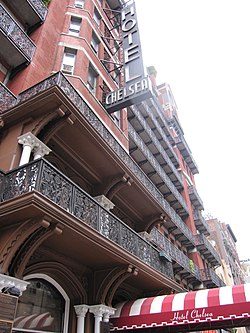The hotel is a red brick structure with elaborate wrought-iron balconies, an homage to Gothic architecture. Most famously, the Chelsea Hotel was home to many culture icons. Writers who lived there were Mark Twain, O. Henry, Dylan Thomas, William S. Burroughs, Arthur Miller, Tennessee Williams, Gore Vidal, Jack Kerouac, and Simone de Beauvoir. Actors and directors who lived there include Stanley Kubrick, Ethan Hawke, Eddie Izzard, Uma Thurman, Dennis Hopper, Elliot Gould, Michael Imperioli, Jane Fonda, and Edie Sedgwick. The hotel is most remembered for its place in music history. Musicians such as Patti Smith (who lived in the hotel with her soulmate, photographer Robert Mapplethorpe), Virgil Thomson, DeeDee Ramone, Edith Piaf, Joni Mitchell, Bob Dylan, Alice Cooper, Janis Joplin, Jimi Hendrix, and Sid Vicious (who infamously stabbed girlfriend Nancy Spungen to death in the hotel in 1978) called the hotel home at some point in their careers. The Hotel Chelsea’s staircase is lined with the work of artists who have lived there, including Frida Kahlo, Edie Sedgwick, and Robert Mapplethorpe.

The exterior and interior of the Hotel Chelsea
The Chelsea Hotel very much reflects the new artistic movements occurring in New York City at the time. It had an independent, fresh, bohemian air to it. It was a place of change, reform, and revolution.
Fun facts: Apparently the ghosts of Nancy Spungen, Dylan Thomas, and Eugene O’Neill haunt the Hotel Chelsea…
-Sarah Allam



